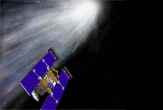 A fundamental ingredient for life has been
discovered in a comet sample,
supporting the idea that such icy objects seeded early Earth with the
stuff
needed to whip up living organisms.
A fundamental ingredient for life has been
discovered in a comet sample,
supporting the idea that such icy objects seeded early Earth with the
stuff
needed to whip up living organisms.
New research firms up past suggestions of glycine, the simplest amino acid used to make proteins, inside samples from the comet Wild 2 (pronounced "Vilt 2").
"This is the first time an amino acid has been found in a comet," said lead researcher Jamie Elsila of NASA's Goddard Space Flight Center in Greenbelt, Md. "Our discovery supports the theory that some of life's ingredients formed in space and were delivered to Earth long ago by meteorite and comet impacts."
How life arose on Earth has long puzzled scientists and philosophers alike, with possible evidence for such building blocks showing up floating about in the cosmos and even inside the mouths of volcanoes.
The new finding, which has been accepted for publication in the journal Meteoritics and Planetary Science, also has implications for finding alien life.
"The discovery of glycine in a comet supports the idea that the fundamental building blocks of life are prevalent in space, and strengthens the argument that life in the universe may be common rather than rare," said Carl Pilcher, director of the NASA Astrobiology Institute, which co-funded the research.
NASA's Stardust spacecraft captured samples of gas and dust from Wild 2 in 2004. The material parachuted to Earth in 2006. Since then, scientists around the world have been analyzing the samples to learn the secrets of comet formation and our solar system's history.
Preliminary testing had suggested glycine was present in the samples. But since glycine is used by terrestrial life, the team couldn't rule out contamination from Earthly sources, according to a NASA statement released today.
"It was possible that the glycine we found originated from handling or manufacture of the Stardust spacecraft itself," Elsila said.
To tease apart contamination from the real McCoy, the researchers recently analyzed the samples for different carbon isotopes, which are versions of the same element with different masses.
Glycine molecules from space tend to have more of the heavier Carbon 13 atoms than glycine from Earth. That's exactly what the team found.
"We discovered that the Stardust-returned glycine has an extraterrestrial carbon isotope signature, indicating that it originated on the comet," Elsila said.